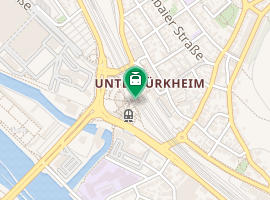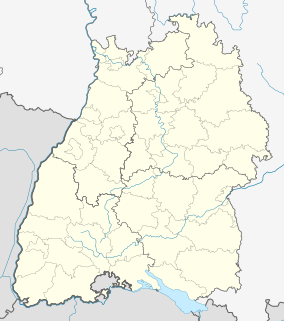Stuttgart-Untertürkheim station
Untertürkheim station is a railway station in Untertürkheim, an outer district of Stuttgart, Germany, on the city's S-Bahn, or S-line. The station formerly included a freight yard and the abbreviation of the station precinct, including the yards, is TSU.
| Through station | |||||||||||||||||||||
| Location | Karl-Benz-Platz 15 Stuttgart, Baden-Württemberg Germany | ||||||||||||||||||||
| Coordinates | 48°46′47″N 9°15′1″E | ||||||||||||||||||||
| Owned by | Deutsche Bahn | ||||||||||||||||||||
| Operated by | |||||||||||||||||||||
| Line(s) |
| ||||||||||||||||||||
| Platforms | 5 | ||||||||||||||||||||
| Connections | RB 11 S 1 | ||||||||||||||||||||
| Other information | |||||||||||||||||||||
| Station code | 6086[1] | ||||||||||||||||||||
| DS100 code | TSU P[2] | ||||||||||||||||||||
| IBNR | 8005775 | ||||||||||||||||||||
| Category | 3[1] | ||||||||||||||||||||
| Fare zone | |||||||||||||||||||||
| Website | www.bahnhof.de | ||||||||||||||||||||
| History | |||||||||||||||||||||
| Opened | 22 October 1845 | ||||||||||||||||||||
| Services | |||||||||||||||||||||
| |||||||||||||||||||||

| |||||||||||||||||||||
| Location | |||||||||||||||||||||
 Untertürkheim Location in Baden-Württemberg  Untertürkheim Location in Germany  Untertürkheim Location in Europe | |||||||||||||||||||||
Located near Württemberg mountain, Untertürkheim is home to the headquarters of Daimler AG and the original Mercedes-Benz assembly plant.
History
On 22 October 1845 the first railway line in Württemberg, the Central Railway (Zentralbahn) opened, connecting the small wine-growing community with Cannstatt, early five kilometres from Untertürkheim. On 7 November 1845 the line was extended to Obertürkheim.
The first station building was a single story and nearly identical with those in Cannstatt and Obertürkheim. Untertürkheim became a popular destination for day trippers, using the new transport system. Hikers and bathers travelled from nearby Stuttgart. The loading dock was mostly used for shipping agricultural produce to Stuttgart.
In the 1890s, the Royal Württemberg State Railways began to develop plans to reduce traffic at Stuttgart Hauptbahnhof (central station). It was proposed to create a bypass track for freight trains providing a direct link between the Eastern Railway and Northern Railway. Untertürkheim station was chosen as the starting point for the new line and as a location for a new freight yard and marshalling yard and Kornwestheim station was chosen as its end point. Construction work started in the spring of 1894. The new freight yard was built next to the street of Cannstatter Straße (Augsburger Straße since 1936) and opened in 1896, in the presence of King William II.
The length of the track field was about 2,300 metres and it was on average 125 metres wide. It included an administration building and several service buildings, loading docks for freight and military transport, five signal boxes for 162 sets of points, a separate platform for railway workers and a roundhouse with four stalls and a water tower.
At the passenger station there was the entrance building, which still exists, and an administration building, consisting of two wings and a central hall. In the southern wing there was until 1960 a post and telegraph office. In the north there was the parcel and express freight office. A residential building was added for railway staff.
Since 1 May 1897, the Rems Railway Curve (Remsbahnkurve) has provided a connection between the freight yard and the Rems Railway and the Murr Railway. Duplication of the line to Kornwestheim was completed on 23 September 1904.
After a few years, the marshalling yard was already overloaded. Planning for its expansion began in 1906. The establishment of a left-bank Neckar railway was debated between 1900 and 1907 to relieve the Eastern Railway. This project was never realized.
In 1911, a project to develop the freight yard failed due to lack of space. Instead, the railway authorities decided to build a new larger yard in Kornwestheim. Untertürkheim freight yard would in future be used only for local freight. Additional tracks to Cannstatt freight yard from this end were opened on 17 November 1912. On 13 November 1923, a connection (closed in the mid-1980s) was opened to the new freight yard in Gaisburg. Since 1958, there has been a connecting track to the station at the river port.
Operations
The station is served by the line S 1 of the Stuttgart S-Bahn. Track 6 was built for the S-Bahn. Track 5 is assigned to S-Bahn services to Bad Cannstatt and track 6 to S-Bahn services to Esslingen. An individual Regionalbahn service operates on track 2, running on the Schuster Railway between Kornwestheim and Untertürkheim. Tracks 1, 3 and 4 are used by non-stopping trains. The station is classified by Deutsche Bahn as a category 3 station.
In the 1980s the yard was declared a satellite of the Kornwestheim yard and lost its importance. Freight is not loaded there. Many of its tracks are used as sidings for freight trains. Part of it is already overgrown and some of its tracks have since been dismantled. The Stuttgart 21 project involves building new sidings in the Untertürkheim track field.
S-Bahn
| Line | Route |
|---|---|
| S 1 | Kirchheim (Teck) – Wendlingen – Plochingen – Esslingen – Untertürkheim – Neckarpark – Bad Cannstatt – Hauptbahnhof – Schwabstraße – Vaihingen – Rohr – Böblingen – Herrenberg |
Regional Transport
| Line | Route |
|---|---|
| RB 11 | Stuttgart-Untertürkheim – Stuttgart-Münster – Kornwestheim Pbf |
Stadtbahn
At Karl-Benz-Platz there are two Stadtbahn stations with the name of Untertürkheim station. One is on line U 13 and the other in Wilhelm-Wunder-Steg is the last stop on line U 4.
| Line | Route |
|---|---|
| U4 | Untertürkheim – Ostendplatz – Charlottenplatz – Rotebühlplatz – Hölderlinplatz |
| U13 | Giebel – Feuerbach Pfostenwäldle – Pragsattel – Bad Cannstatt – Hedelfingen In school holidays and outside the peak only between Feuerbach and Hedelfingen. |
References
Footnotes
- "Stationspreisliste 2020" [Station price list 2020] (PDF) (in German). DB Station&Service. 4 November 2019. Retrieved 15 November 2019.
- Eisenbahnatlas Deutschland (German railway atlas) (10 ed.). Schweers + Wall. 2017. ISBN 978-3-89494-146-8.
- "Tarifzoneneinteilung" (PDF). Verkehrs- und Tarifverbund Stuttgart. 1 April 2020. Retrieved 16 April 2020.
Sources
- Bruder, Hermann. Herzstück im Schwabenland – Untertürkheim und Rotenberg. Ein Heimatbuch (in German). Issued on behalf of Bürgervereins Untertürkheim e. V.
- Räntzsch, Andreas M. (1987). Stuttgart und seine Eisenbahnen. Die Entwicklung des Eisenbahnwesens im Raum Stuttgart (in German). Heidenheim: Verlag Uwe Siedentop. ISBN 3-925887-03-2.
- Scharf, Hans-Wolfgang (2006). Die Eisenbahn im Kraichgau. Eisenbahngeschichte zwischen Rhein und Neckar (in German). Freiburg (Breisgau): EK-Verlag. ISBN 3-88255-769-9.
External links
- "Pictures of the entrance building" (in German). wirtemberg.de. Retrieved 2 April 2011.
- "Article on Stuttgart 21 in Untertürkheim" (in German). wirtemberg.de. Retrieved 2 April 2011.
- "Details of the station" (in German). City of Stuttgart. Retrieved 2 April 2011.
- "Rail transport: The first train from Cannstatt to Untertürkheim" (PDF: 655 kB) (in German). bv-untertuerkheim.de. Retrieved 2 April 2011.